![]()
![]()
![]()
Use LEFT and RIGHT arrow keys to navigate between flashcards;
Use UP and DOWN arrow keys to flip the card;
H to show hint;
A reads text to speech;
31 Cards in this Set
- Front
- Back
|
Allocative Efficency |
This is achieved when resources are used to produce goods and services which consumers want and value most highly e.g Social Welfare is maximised. Occurs when P=MC. |
|
|
Productive Efficency |
A firm has productive efficency when its products are produced at the lowest average cost. This minimum resource means firms produce at maximum output e.g when MC=AC. |
|
|
Dynamic Efficency |
This is achieved when resources are allocated efficently over time, in markets where competition encourages innovation. |
|
|
Perfect Competition |
Perfect competition is a market where there is a high degree of competition, but the word ‘perfect’ does not mean it maximises welfare or produces ideal results. There are few industries which fit this type of market structure, one example may be agriculture |
|
|
Characteristics of Perfect Competition |
Firms are price takers, many buyers and sellers, freedom of entry and exit from the industry, perfect knowledge, homogenous goods. |
|
|
Perfect Competition Graph |
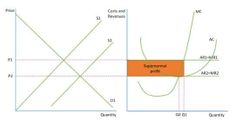
It is possible in the SR for firms to make supernormal profit, normal profit or a loss. However in the LR they are only able to make normal profit as freedom of entry and exit means if supernormal profit is possible other firms will enter and remove it. |
|
|
Efficency of Perfect Competition |
They are productively efficent as they produce where MC=AC, they are also allocatively efficent since they produce where P=MC. |
|
|
Monopolisitc Competition |
Monopolistic competition is a form of imperfect competition, with a downward sloping demand curve. It lies in between the two extremes of perfect competition and monopoly, both of which rarely exist in a pure form in real life. |
|
|
Characteristics of Monopolistic Competition |
Large numbers of buyers and sellers, no barriers to entry or exit, differentiated or non-homogenous goods. |
|
|
Monopolistic Competition Graph |
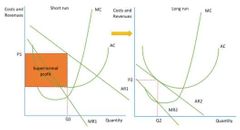
In the short run, firms can make supernormal profits, losses or normal profits. However, due to the lack of barriers to entry/exit, firms can only make normal profits in the long runn as other firms will enter and take up this profit, similarly to Perfect Competition. |
|
|
Efficency of Monopolistic Competition |
They will not be allocatively or productively efficent as AC=AR and MR=MC. |
|
|
Oligopoly |
Oligopoly is where there are a few firms that dominate the market and have the majority of market share, although this does not mean there won’t be other firms in the market. |
|
|
Characteristics of Oligopoly |
Products are differentiated, high concentration ratio, firms must be independent meaning the actions of one will affect another, there are barriers to entry. |
|
|
Kinked Demand Theory |
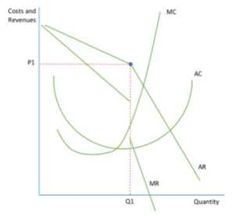
If a firm raises its price, other firms will not follow as they want to remain competitive. However, if a firm lowers its price others will follow. This leads to a kinked demand curve and a gap in the MR curve and so a rise or fall in cossts is likely to have no impact on price or output, meaning a stable market. |
|
|
N-Firm Concentration Ratiosj |
The concentration of supply in the industry can be indicated by the concentration ratio which measures the percentage of the total market that a particular number of firms have . The 3 firm concentration ratio shows the percentage of the total market held by the three biggest firms. |
|
|
N-Firm Concentration Ratios Formula |
(total sales of n firms/ total size of market) X 100 |
|
|
Game Theory |
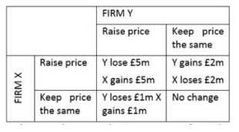
Game theory explores the reactions of one player to changes in strategy by another player. The aim is to examine the best strategy a firm can adopt for each assumption about its rival’s behaviour. |
|
|
Dominant Stratergy |
It is a strategy that guarantees the player the highest payoff or outcome, regardless of what the other players do. For example, in rock-paper-scissors, throwing rock is not a dominant strategy because it can be beaten by paper. |
|
|
Nash Equilibrium |
Where neither player is able to improve their position and has optimised their outcome based on the other players expected decision. They have no incentive to change their behaviour, without someone else changing theirs. |
|
|
Price Wars (Types of Price Competition) |
These occur in markets where non-price competition is weak, a price war will drive prices down to levels where firms are frequently making losses. |
|
|
Predatory Pricing (Types of Price Competition) |
This occurs when an established firm is threatened by a new entrant or if one firm feels that another is gaining too much market share. The established firm will set such a low price that other firms are unable to make a profit and so will be driven out the market. |
|
|
Limit Pricing (Types of Price Competition) |
In order to prevent new entrants, firms will set prices low (the limit price). The price needs to be high enough for them to make at least normal profit but low enough to discourage any other firm from entering the market. |
|
|
Types of non-price competition |
Advertising, loyalty cards, branding, quality, customer service |
|
|
Efficency of Oligopoly |
Firms will be statically inefficent, since they are not productively or allocatively efficent. |
|
|
Monopoly |
Pure monopoly exists where one firm is the sole seller of a product in a market , in the real world, pure monopoly rarely exists but a firm can be legally considered as having monopoly power if it has more than 25% of the market. |
|
|
Monopoly Graph |
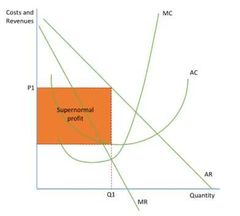
The demand curve for a monopolist will be the demand curve for the product. Since there is a monopoly, firms may be able to earn supernormal profits or a loss in the long run as there is no freedom of entry and exit to the market. |
|
|
Third degree price discrimination |
This is when monopolists charge different prices to different people for the same good or service . There are different examples of where this can occur: different times of the day, for example peak and off-peak train times; different prices in different places, such as between London and smaller towns |
|
|
Natural Monopoly |
Some companies are said to be natural monopolies. In these industries, the economies of scale are so large that even a single producer is not able to fully exploit all of them . These are decreasing cost industries. There are no pure natural monopolies in real life, but some examples include the National Grid, Royal Mail |
|
|
Monopsony |
This is where there is only one buyer in the market, and other than this it has the same basic characteristics as monopoly. They can prevent new firms entering the market and aim to profit maximise. |
|
|
Characteristics of contestable markets |
Perfect knowledge, freedom of entry and exit, absence of sunk costs, low product loyalty |
|
|
Types of barrier to entry and exit |
Legal barriers, marketing barriers, pricing decisions of incumbent firms, sunk costs/start up costs, others firms have acess to economies of scale. |

